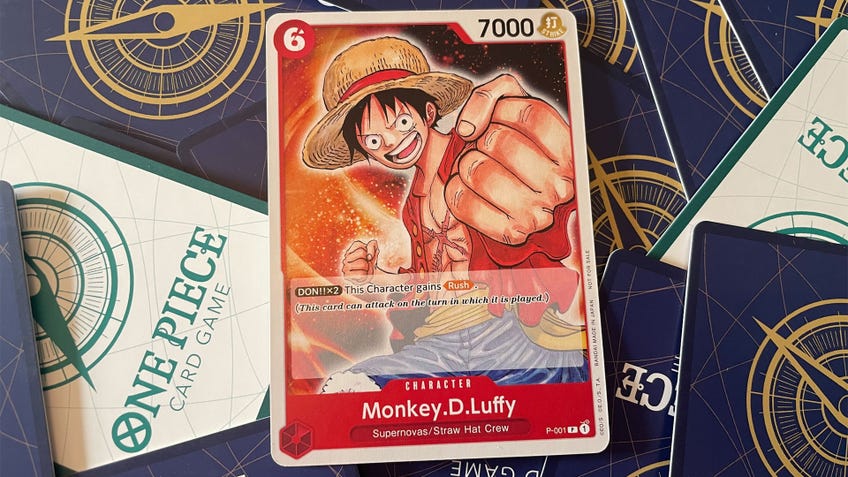How to play One Piece Card Game: rules, how to build a deck and how to win explained
Become King of the Pirates.
While catching up with all 1,000-plus chapters of One Piece might take you a while, learning how to play the One Piece Card Game is thankfully much more straightforward.
How to play One Piece Card Game
- What is the One Piece Card Game?
- How to build a One Piece Card Game deck
- One Piece Card Game setup
- One Piece Card Game rules
- How to win the One Piece Card Game
- Can you play the One Piece Card Game with more than two players?
The One Piece Card Game brings one of the most popular manga and anime series to its own trading card game, allowing players to battle as Luffy, Sanji, Nami and other familiar characters from the long-running franchise.
Two players battle to wear their opponent down to zero life by playing characters from their deck, paying for cards and boosting their power with DON!! cards - a reference to the manga’s use of the Japanese onomatopoeia as a sound effect. Each deck is led by a leader who has their own powerful abilities, and must be defended against attacks from the opponent.
By using your cards’ abilities, attacking your opponent’s leader and defending your own characters from attacks, you’ll be able to take victory and become King of the Pirates. To take your first step onto the Grand Line, read on to learn how to play the One Piece Card Game.
What is the One Piece Card Game?
The One Piece Card Game is a trading card game based on the popular manga and anime series by Eiichiro Oda. The One Piece Card Game includes cards based on familiar characters such as Monkey D. Luffy, Sanji, Nami and the rest of the Straw Hat Pirates, plus iconic villains like Buggy the Clown, Sir Crocodile and Donquixote Doflamingo.
The card game sees two players playing characters, events and other cards from their deck in the hope of reducing their opponent’s life to zero first.
As a trading card game, the One Piece Card Game allows players to build and customise their own decks, building around certain characters, play styles and gameplay effects in the hope of claiming victory.
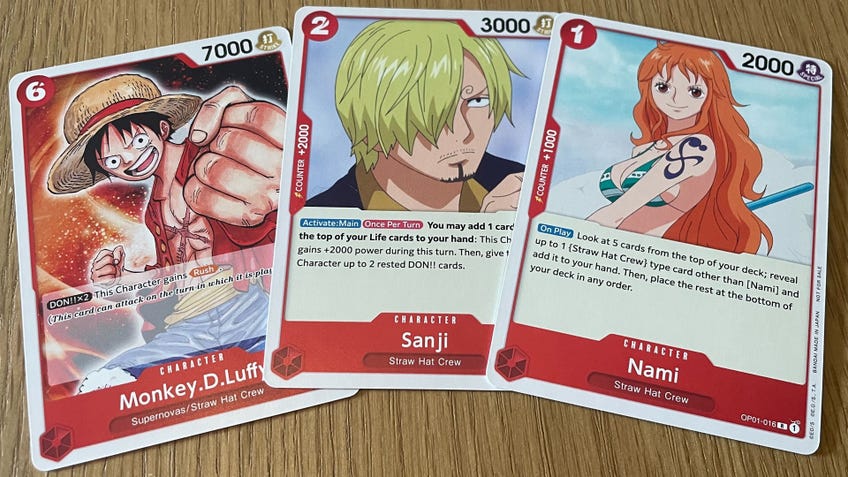
How to build a One Piece Card Game deck
To build a One Piece Card Game deck, first you will need to choose a leader card. These cards typically represent some of One Piece’s most iconic characters, such as Monkey D. Luffy.
Once you have chosen a leader, you can build your main deck. Your One Piece Card Game deck must include exactly 50 cards. These cards must be the same colour as your leader card. (Your leader card does not count as part of your main deck.) If a leader card has multiple colours, it is treated as both of those colours, allowing multiple colours to be included in the deck.
No more than four copies of the same card, as determined by their card number, are allowed to be included in the same deck. One Piece Card Game card types include character cards, event cards and stage cards, in six colours: red, green, blue, purple, black and yellow.
As well as your leader card and deck, you will need to create a separate DON!! deck that contains exactly 10 DON!! cards. These cards are effectively the same in terms of gameplay effect - although they may have different artwork - and are used to pay for other cards, activate effects and boost the power of your characters and leader during attacks.
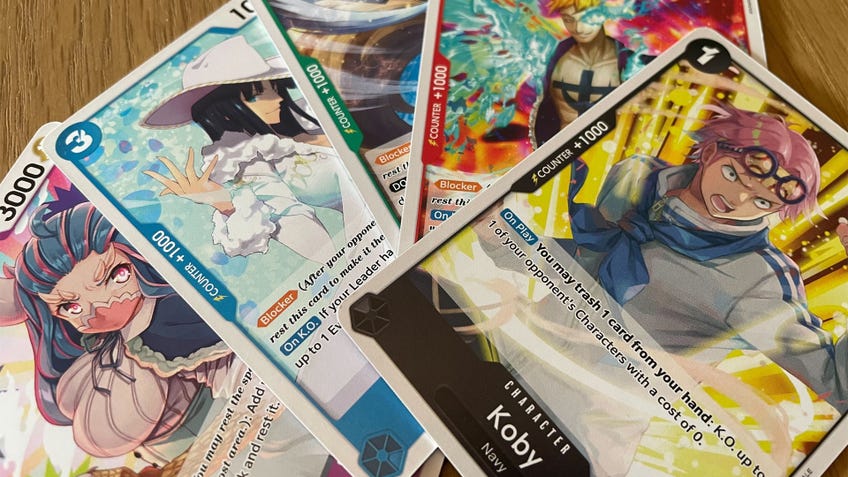
One Piece Card Game setup
- Shuffle your deck and DON!! deck.
- Place your deck and DON!! Deck facedown in their respective areas. Your DON!! deck is placed on the left of your field, with your main deck to the right - leave a space below it for your trash/discard pile.
- Between your DON!! Deck and trash pile is what’s known as your cost area. This is where DON!! cards will be placed as they are drawn. DON!! cards are used to pay for character cards, effects and to boost your other cards’ power.
- Place your leader card to the left of your deck, leaving a space between the two for your stage card.
- Above your leader, stage card area and deck is the character area, where any played character cards should be placed during the game.
- Decide which player will go first. The official One Piece Card Game rules recommend using rock-paper-scissors, or another method. The winner chooses whether they want to go first or second.
- Each player draws five cards from the top of their deck. Each player may mulligan once by shuffling their entire hand back into their deck and drawing another five cards from the top.
- Place a number of cards equal to the life value of your leader - which can be seen in the bottom-right corner - in a facedown pile in your life area, above your DON!! deck. You can’t look at or reorder the cards in your life area.
- You’re ready to play, starting with the first player. (Be sure to take note that the first player will not draw a card during their first turn, and only draws a single DON!! card on their first turn.)
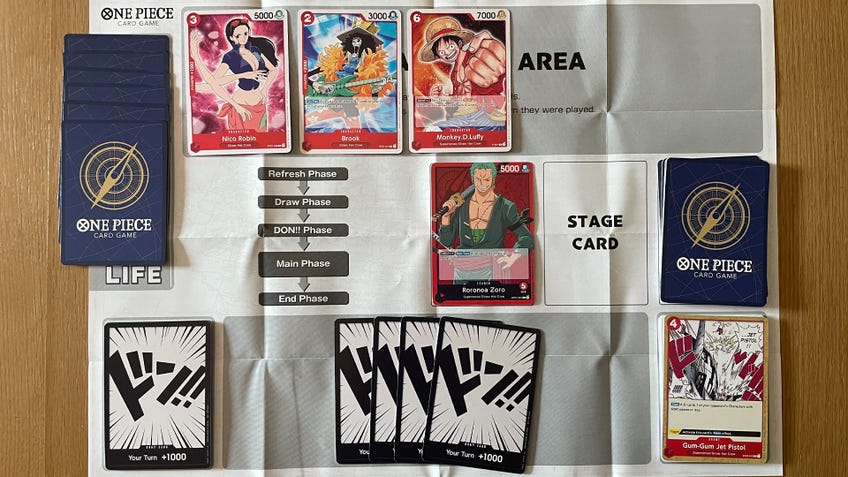
One Piece Card Game rules
Turns in the One Piece Card Game consist of five key phases:
- Refresh Phase
- Draw Phase
- DON!! Phase
- Main Phase
- End Phase
1. Refresh Phase
The Refresh Phase is when any “until the start of your next turn” effects end.
Return any DON!! cards attached to your leader and character cards to your cost area. Then, reset any rested cards - signified by turning them 90 degrees sideways, similar to tapping in Magic: The Gathering - to active by turning them upright.
2. Draw Phase
Draw one card from the top of your deck. The first player skips this step on their very first turn.

3. DON!! Phase
Draw two DON!! cards from your DON!! deck and place them face-up in your cost area. The first player only draws and places a single DON!! card on their first turn. DON!! cards are added to your cost area in an active position, orientated vertically.
4. Main Phase
The main phase is where most of the One Piece Card Game’s action happens. Players can perform any combination of the following four actions, in any order and as many times as they like:
- Play a card
- Attach DON!! cards
- Use card effects
- Attack
Play a card
To play a card from your hand, rest DON!! cards in your cost area (by turning them 90 degrees sideways, like tapping in Magic: The Gathering). The number of cards you rest must be equal to the card’s cost, as noted in the top-left corner.
Character cards and stage cards remain on the field once played; character cards are placed above your leader and deck, while stage cards are placed between your leader and deck.
Each player can have only a single stage card in effect at one time; when you play a new stage card, discard the existing stage card to your trash pile.
Characters cannot attack on the turn they are played, or on each player’s first turn. Event cards activate immediately before being discarded to your trash.

Attach DON!! cards
DON!! cards that have not been rested - in other words, they are still active as signified by being orientated upright - can be attached to your leader or another character.
Each DON!! card adds +1000 power to the attached character. Multiple DON!! Cards can be attached to a single character.
When a card with DON!! cards attached leaves the field - for instance, by being defeated - the attached DON!! cards return to your cost area rested (turned 90 degrees sideways).
Use card effects
Character cards and your leader can use the effects listed in their card text. Card effects may require specific conditions, as listed on the card:
- DON!! xX: This effect requires the card to have at least X number of attached DON!! cards to activate.
- DON!! -X: This effect requires the player to return X number of DON!! cards from their field (either attached to a leader or character card or in the cost area) to their DON!! deck.
- Activate (Main) (X): This effect can be activated during the Main Phase by resting X number of active DON!! cards in your cost area. (By turning them sideways, similar to paying a card’s cost.)
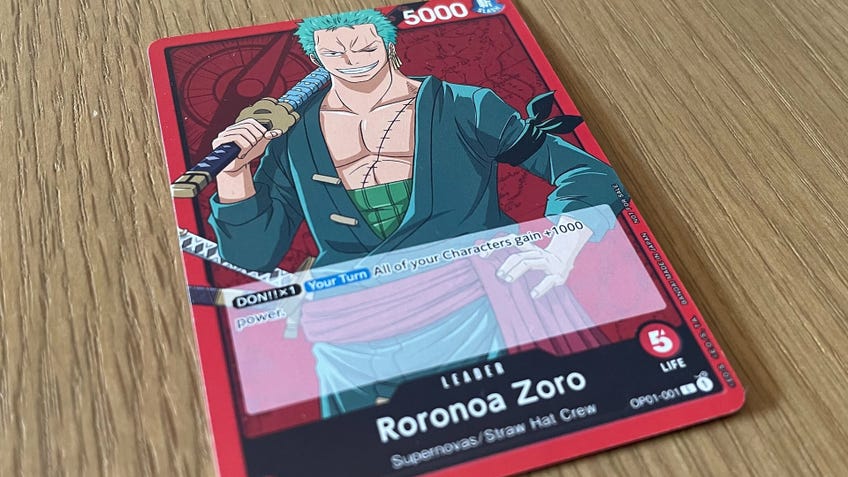
Attack
Attacking is the main way that players move towards victory in the One Piece Card Game, by attacking their opponent and aiming to reduce their life to zero.
When attacking, players can choose to target their opponent’s leader or a rested character controlled by their opponent. Each player cannot attack on their first turn, and characters can’t attack on the same turn they are played. (Similar to Magic: The Gathering’s summoning sickness rule.)
To attack with your leader or a character, rest the active card by turning it 90 degrees sideways and announce your target. You can target your opponent’s leader or one of their rested characters. Resolve any “When Attacking” effects once you have chosen a target.
If a card has a Blocker ability, it now activates; the keyword allows an active card with the Blocker keyword to be rested to take the place of another card being attacked. The defending player can then choose whether to play a Counter card from their hand, trashing a character card in order to add the specified Counter value to the defending card's power or an event card to activate the effect as explained on the card.

Once any effects have been resolved, the power values of the two cards are compared. (Remember that each attached DON!! card adds +1000 power.) A card’s power value can be found in its top-right corner. If the attacker’s power is greater than or equal to the card it is attacking, the attack is successful.
If a leader is attacked successfully, the defending player takes one damage by adding a card from their life area to their hand by drawing from their facedown pile in the life area. If the drawn card has a Trigger effect, the card may be revealed to activate the Trigger effect. If a player takes damage but no cards are left in their life area, they lose the game.
If a character is attacked successfully, the defending card is KO’d and discarded to the player’s trash pile.
If a card successfully defends against an attack, nothing happens - no player takes damage or loses any cards.
5. End Phase
During the End Phase, all effects that are active "during this turn" are ended. After that, play passes to your opponent for their turn.
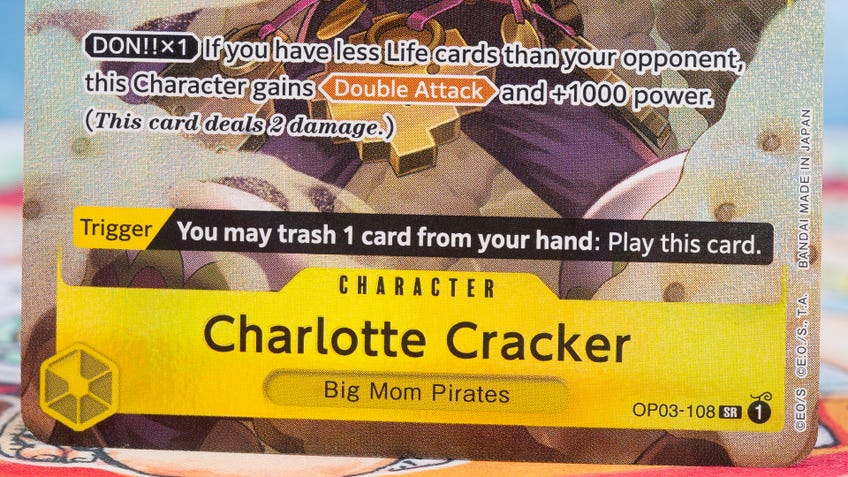
How to win the One Piece Card Game
To win the One Piece Card Game, you must reduce your opponent’s life to zero by successfully attacking their leader card.
When a player would take damage from a successful attack on their leader and has no more cards to draw from their life area, they lose.
A player also loses if their deck runs out - as soon as there are zero cards left in your deck, you lose.
If both players suffer defeat at the same time, the game is a draw instead.
One Piece Card Game keywords explained
- Banish: When the opponent suffers life damage, the card from their life area is discarded to their trash area instead of going in their hand. Any Trigger effects are ignored.
- Blocker: Allows the card to be rested to take the place of another card being attacked
- Counter: Counter effects can be activated when you are attacked, after a target is selected and any Blocker effects have been resolved. The Counter effect allows a character card to be trashed to add the specified value to the defending card's power, or an event to activate the effect as detailed on the card.
- Double Attack: Deal two damage to the opponent when their leader is successfully attacked, instead of one
- Rush: The character can attack on the same turn it’s played
- Trigger: Activates when the card is drawn from the life area after a player suffers damage. The card must be revealed to activate the Trigger effect, but you can optionally choose to not reveal the card by not activating the effect.
Can you play the One Piece Card Game with more than two players?
The One Piece Card Game’s official rules are designed to be played with only two players. This means that you can’t officially play the One Piece Card Game with three, four or more people.
However, some enterprising fans may well come up with their own unofficial variants to allow multiplayer formats in time!
